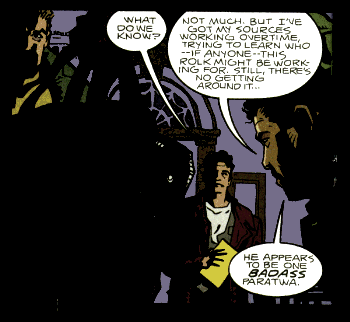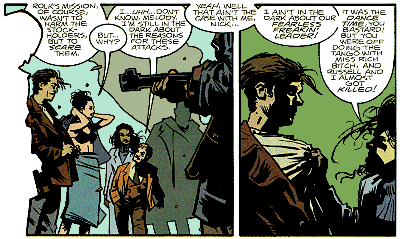Gemini Blood

 I didn’t really give Gemini Blood the chance it deserved.
I didn’t really give Gemini Blood the chance it deserved.
The title sounded like an adolescent carnage-orientated Image Comics series, which turned me off a bit before I even saw it. The promotional material explained that it was about “paratwa”, pairs of genetically engineered assassins who shared a single consciousness… which sounded interesting, but a little simplistic to base a series around. Then the covers of the first two issues were dominated by a pair of guns-blazing crash-test-dummy look-alikes. Ugh. The art was a bit flat and sketchy, and the colors were dark, dark, dark… to the point that it was often hard to tell who was who, and to even see what was going on. And there was lots of violent fighting and killing.
 Not an auspicious or promising start. Although I saw that there was more to the series than monsters with guns (characters and ideas, for example), issues three and four went unread as I bought them. But I was determined to buy and read the entire first storyline, to give it a chance to win my interest. But by the time “Species: Paratwa” (the first story arc) ended with #6, the word was that the series would soon be cancelled. I decided at that point that it had (in a sense) become a “limited series” and kept buying it until it ended.
Not an auspicious or promising start. Although I saw that there was more to the series than monsters with guns (characters and ideas, for example), issues three and four went unread as I bought them. But I was determined to buy and read the entire first storyline, to give it a chance to win my interest. But by the time “Species: Paratwa” (the first story arc) ended with #6, the word was that the series would soon be cancelled. I decided at that point that it had (in a sense) become a “limited series” and kept buying it until it ended.
In doing so, I was rewarded with a few interesting stories. (And lighter coloring.) For the record, the overly dark coloring was attributed to technical errors and improved within a few issues. It remained fairly flat and dark, but at least it didn’t obscure the drawings themselves, and it did generally fit the dystopic mood of the series.
That dystopic flavour contributed to my ambivalence toward the book. Hinz had some rather clever twists on the future development of society, but many of them seemed arbitrarily bizarre rather than reflecting a natural evolution of human psychology. Unless Hinz was just saying that we (as a society) are going bonkers (which was definitely one of his themes), I didn’t see the point of (for example) the aerial cemetary. The dystopia seemed more an excuse for introducing oddities than a cautionary device.
 Despite the name of the series, it was clear by the end that the focus of it would have been not the gemini-blooded assassins, but the small rag-tag band of mercenaries who are contracted to fight them in the first story. This became particularly clear in issue #7, a largely self-contained spotlight on Gillian, one of the group, and his conflicted
Despite the name of the series, it was clear by the end that the focus of it would have been not the gemini-blooded assassins, but the small rag-tag band of mercenaries who are contracted to fight them in the first story. This became particularly clear in issue #7, a largely self-contained spotlight on Gillian, one of the group, and his conflicted
motivations for participating in their mission to hunt down the paratwa.
By the end of the two-part story that followed (and concluded the series), I started getting a sense of how this series could have worked on an ongoing basis, as the team moved from one assignment to the next, uncovering what’s really going on with the paratwa attacks on Flikker-Wixon corporation, the rumoured Loothka terrorizing the Church of the Queue in the wilds of Wisconsin, etc.
It had some potential. But between the art, the length of the introductory story arc, the initial coloring problems, and various other factors, Gemini Blood didn’t really have much of a chance.
